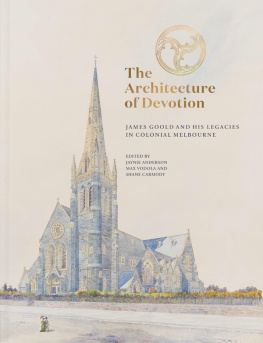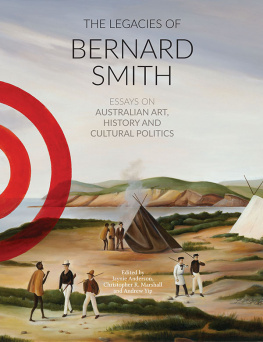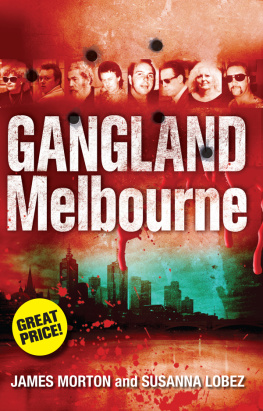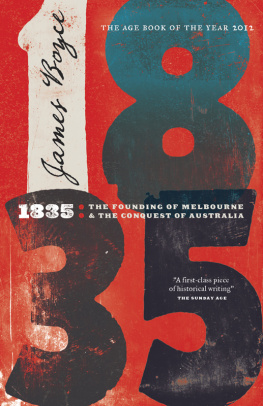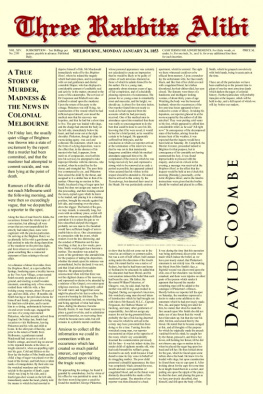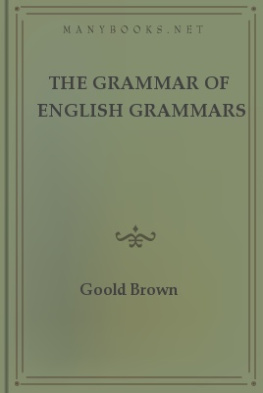Table of Contents
THIS IS NUMBER TWO HUNDRED AND FOUR
IN THE SECOND NUMBERED SERIES OF THE MIEGUNYAH VOLUMES
MADE POSSIBLE BY THE
MIEGUNYAH FUND
ESTABLISHED BY BEQUESTS
UNDER THE WILLS OF
SIR RUSSELL AND LADY GRIMWADE.
MIEGUNYAH WAS RUSSELL GRIMWADES
HOME FROM 1911 TO 1955,
AND MAB GRIMWADES HOME
FROM 1911 TO 1973.

The Architecture of Devotion
JAMES GOOLD AND HIS LEGACIES IN COLONIAL MELBOURNE
EDITED BY
JAYNIE ANDERSON
MAX VODOLA AND
SHANE CARMODY

THE MIEGUNYAH PRESS
An imprint of Melbourne University Publishing Limited
Level 1, 715 Swanston Street, Carlton, Victoria 3053, Australia
www.mup.com.au

First published 2021
Text individual contributors, 2021
Images individual contributors, various dates
Design and typography Melbourne University Publishing Limited, 2021
This book is copyright. Apart from any use permitted under the Copyright Act 1968 and subsequent amendments, no part may be reproduced, stored in a retrieval system or transmitted by any means or process whatsoever without the prior written permission of the publishers.
Every attempt has been made to locate the copyright holders for material quoted in this book. Any person or organisation that may have been overlooked or misattributed may contact the publisher.
Designed by Pfisterer + Freeman
Printed in China by 1010 Printing Asia Ltd

9780522878165 (hardback)
9780522878295 (ebook)
Research for this book was funded by the Australian Government through the Australian Research Council Discovery Grant.

(COVER IMAGE)
H.E.W.
Artists impression of WW Wardells design for the spire of St Ignatius Church, Richmond, 1891
pen and ink with watercolour on paper
61.5 43.5 cm
collection: St Ignatius Church,Richmond
Contents
| Jaynie Anderson, Max Vodola and Shane Carmody |
| Max Vodola |
| Mark G McGowan |
| Matthew Beckmann |
| ARCHITECTURE |
| Paola Colleoni |
| Lesley Alway |
| ART |
| Jaynie Anderson |
| Ruth Pullin |
| Rafael Japn |
| BOOKS AND PUBLISHING |
| Kevin Molloy |
| Huw Sandaver |
| Clara Geoghegan |
| Catherine Kovesi |
| Shane Carmody |
| Colin Nettelbeck |
Acknowledgements
This book is the product of an Australian Research Council Discovery Project. We would like to thank the ARC, the University of Melbourne and the University of Divinity for their support. The publishing of the book was made possible through the generosity of Maria Myers AC and Allan Myers AC, together with a grant from the Natalie Mary OSullevan Trust. We are very grateful for this assistance, which has ensured a book of the highest quality.
The essays herein began as papers at a symposium held in February 2020. We would like to express our thanks to the Rector of Newman College, Father Frank Brennan SJ, AO, and the Provost of Newman College, Mr Sean Burke, for hosting the first day of the symposium. We would also like to thank the Australian Institute of Art History for its assistance with the symposium.
Throughout this project we have enjoyed the support of a talented team of scholars and experts. Dr Callum Reid has assisted with research; Helen Gill has provided excellent analysis of the paintings that belonged to Goold; Kerrie Burn, Nick Gellatly and Huw Sandaver at Mannix Library have been critical in identifying books from Goolds library and have created a very fitting new home for them. Huw Sandaver has also ensured wide access to much of Goolds collection through imaginative use of digital platforms. Dr Paola Colleoni, as the holder of the ARC PhD Scholarship, has generously shared her knowledge of Goolds most famous architect, William Wilkinson Wardell.
The Archdiocese of Melbourne and many religious orders and congregations have been very helpful. We would like to record our thanks to: Most Rev. Peter A. Commensoli, Archbishop of Melbourne; Most Rev. Denis Hart, Emeritus Archbishop of Melbourne; Very Rev. Werner Utri, Dean of St Patricks Cathedral; Dr Donna Bailey, Diocesan Archivist and Professional Standards Office, Catholic Diocese of Sandhurst, Bendigo; Dr J. Ben Boonen, Archivist, Christian Brothers, Melbourne; Imogen Kennard-King, Collections Registrar, Sisters of Charity Congregational Archives; Father James Clarke, Parish of St Mary of the Angels, Geelong; Father Denis Stanley, Rector of Corpus Christi Seminary; Father Michael Head SJ, Archivist for the Australian Jesuit Province; Damien Burke, Irish Jesuit Archives; Sr Angela Bayliss NDS, Archivist for the Sisters of Notre Dame de Sion; and Fr Huy Viet Nguyen SJ, former Parish Priest of St Ignatius Richmond.
All the authors together acknowledge their debt to Belinda Nemec for her skilful editing of the text, and to Cathryn Smith at Melbourne University Press for her thoughtful management of the project.
With this project complete, James Alipius Goold can now been seen in a new light. We did not begin that re-evaluation; that credit properly belongs to the late Father John Rogan. Johns legacy and indeed much of the legacy of Goold has been preserved, recorded and made accessible through the tireless work of the Archdiocesan Archivist, Rachel Naughton. Without Rachel, the research project, this book and its companion volume, The Invention ofMelbourne: A Baroque Archbishop and a Gothic Architect (MUP, 2019), would not have been possible. It is with gratitude and deep respect that we dedicate this book to her.
Jaynie Anderson, Max Vodola and Shane Carmody
Introduction

JAYNIE ANDERSON, SHANE CARMODY AND MAX VODOLA

O n Sunday 26 April 1885, Archbishop James Alipius Goold set the foundation stone for the completion of the Jesuit Church of St Ignatius in Richmond, an inner suburb of Melbourne. After a delay of some fifteen years since the opening of the first part of the nave, the Jesuits and their parishioners had resolved to build a church more fitting to the needs of a much larger Catholic population. Their architect, William Wilkinson Wardell, proposed a major expansion of the original scheme, adding a great crossing, deep chancel and radiating ambulatory chapels. In what was to be his final contribution to Catholic architecture in Victoria, Wardell returned to the French Gothic that had inspired his first project, St Patricks Cathedral. Perhaps to inspire donors, the Jesuits commissioned two artists to make images showing the completed church. One, identified only by his initials,

